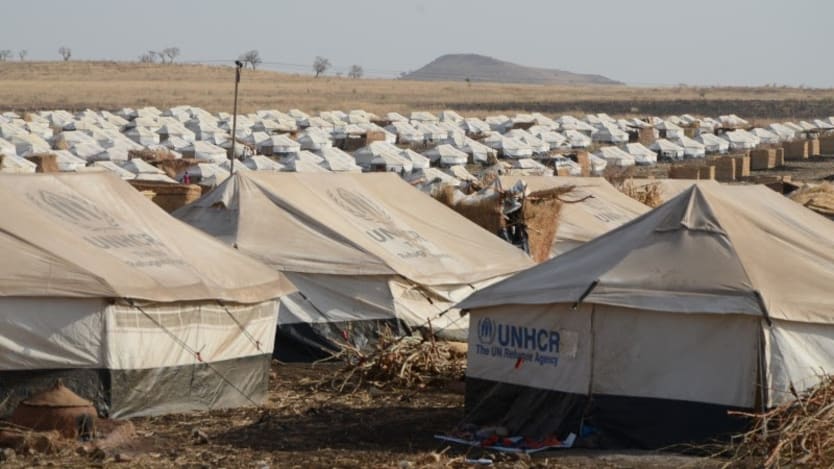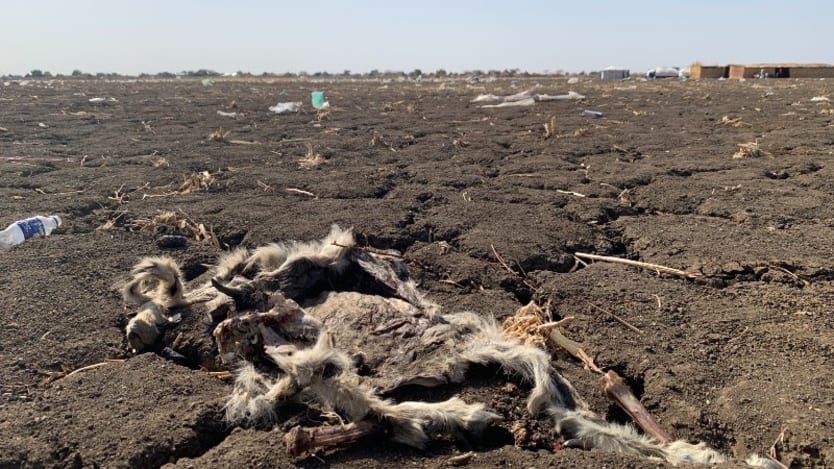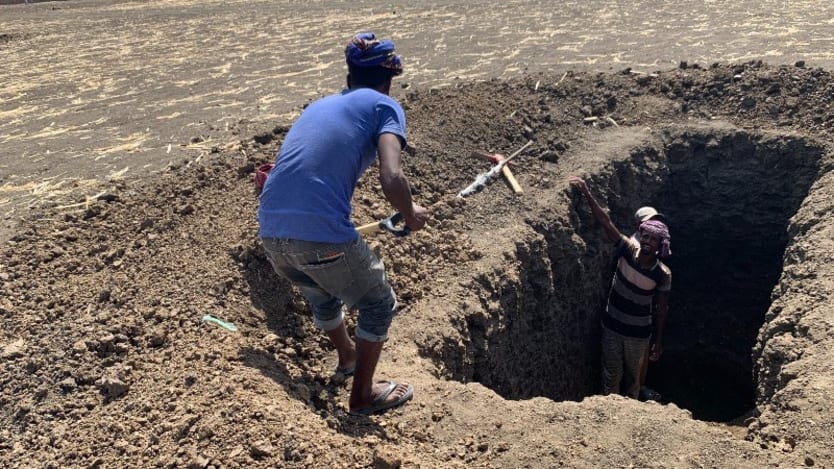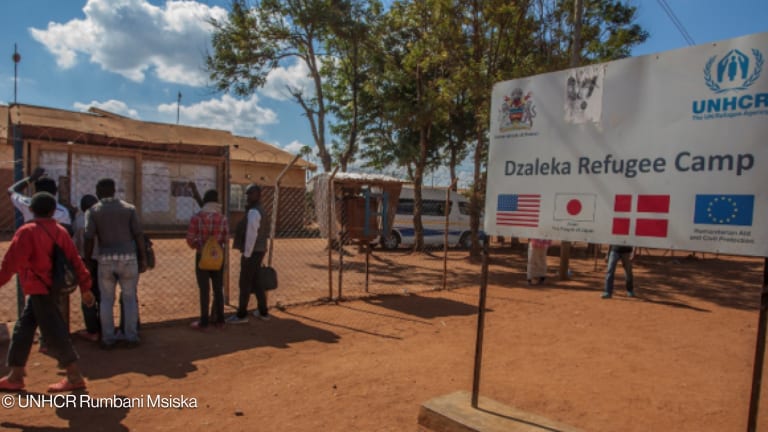
TUNAYDBAH CAMP, Sudan — It’s a two-hour drive on a tarmac road from the main city of al-Qadarif, followed by another hour of off-roading on dusty earth, weaving through parched bushes and herds of sheep and camels, before reaching Tunaydbah, a camp in eastern Sudan now hosting over 13,300 refugees who’ve fled violence in northern Ethiopia.
While right now the drive is difficult, it's expected to become much worse. It’s feared that the coming rainy season will further complicate or cut off access to the camps, threatening the safety and health of those living there. Substantial resources are needed to make extensive upgrades to infrastructure at both Tunaydbah and Um Rakuba, another camp hosting refugees. And these changes need to happen quickly.
“We are very concerned about the rains. The whole community is raising questions about how we can live here when the rains come. We won’t be able to walk five steps in front of us,” said Esayas Belay, a camp resident and community leader.
Impeded access, flash floods, and health risks
Many aid workers make the three-hour commute twice per day. Newly arrived refugees are also transported about 9 hours from the Ethiopian border on a daily basis, and heavy trucks bring supplies to the camp.
The tent city of Tunaydbah lies on “black cotton” soil — a dirt that absorbs water easily, becoming a muddy mess when rains hit. It’s also infamously difficult to build on.

This soil can also be dangerous. For example, the rains can cause a bathroom to collapse while a person is using it, said Julian Zakrzewski, Sudan country director at the Danish Refugee Council.
The other camp, Um Rakuba, is about an hour and a half from al-Qadarif and hosts over 20,500 refugees. It doesn’t sit on black cotton soil but has its own problems. It is located in a valley surrounded by hills, making it vulnerable to flash floods. As the first camp to receive refugees, tents were haphazardly set up at the onset of the crisis.
“The whole community is raising questions about how we can live here when the rains come. We won’t be able to walk five steps in front of us.”
— Esayas Belay, refugee camp resident and community leader“You can see the tents that are pitched right on the side of the hills where the water is obviously going to come through and just swipe everything in its way,” said Anika Krstic, country director at Plan International’s Sudan office.
The winding dirt road to Um Rakuba is also at a lower elevation than the surrounding area, meaning it could turn into an “ocean” once the rains start, said Nic Paulsen, head of programs at the World Food Programme.
Neither of these locations — sites chosen by the Sudanese government — is ideal for hosting large numbers of people, aid workers told Devex.
Both sites were previously refugee camps, established in the 1980s in response to famine and largely decommissioned around 2000. Because land ownership is complex in the area, the local government fell back on using these camps because of the urgent need for space.
There is also a problem with open defecation in the camps, and the coming rains raise concern about an uptick in waterborne and vector-borne diseases. In preparation, a cholera vaccination campaign recently began in the camps, said Seda Kuzucu, senior emergency coordinator in Sudan at the UN Refugee Agency.
Another concern is referrals. Only basic health care is provided at the camps, meaning people must travel to hospitals for surgeries, such as cesarean sections.
Referral hospitals closest to the camps have reported being understaffed, lacking blood banks because of broken refrigerators, and water shortages and problems with sterilization. The United Nations Population Fund is surveying these referral hospitals to provide support, with an urgency to strengthen these facilities before the rains start.
There is a need to pre-position lifesaving supplies in the camps and find innovative ways to get people to hospitals during the rains, said Rania Hassan, head of health at UNFPA Sudan. The organization is advocating for the increased use of three-wheeled vehicles to serve as low-cost, mini ambulances. These “tuk-tuks” are lighter than traditional cars, meaning they are less likely to get stuck in the mud.
Infrastructure upgrades and funding concerns
The rainy season in al-Qadarif state is long. It is expected to start around May and intensify in the subsequent months through October.
“As soon as the first rain falls, you cannot set up any concrete construction anymore,” DRC’s Zakrzewski said. “It's really a race against time.”
Climate change makes the rainy seasons less predictable, UNHCR’s Kuzucu said.
“If the rain comes earlier, it’s a concern,” she said, as these projects take time.
Humanitarian actors said there is a need to create a gravel road from Tunaydbah camp to the tarmac road, level the dirt road to Um Rakuba, replace tents with more permanent structures, and install drainage systems. Bathrooms will need to be rebuilt, fortified, and moved away from areas prone to flooding.

The humanitarian sector also plans to move tents in Um Rakuba camp that are located in flood zones, said Ameen Ibrahim, who was organization coordinator with Sudan’s Commission for Refugees through the end of January.
The Swedish government is also supporting the creation of bases in the camps with tents to house humanitarian workers so that they won’t need to commute to al-Qadarif.
The humanitarian sector is already taking steps to make these changes. An interagency flood response was drafted, and a technical team was created, Kuzucu said. UNHCR and its partners are conducting a topography survey for both camps.
These extensive infrastructure upgrades will be expensive, and there are concerns over funding.
“The main issue is the funding. This needs a lot of funds,” said Abdel Monaem Osman, camp manager with the government’s Commission for Refugees at Tunaydbah.
COVID-19 is largely an afterthought in camps hosting Ethiopian refugees
In eastern Sudan's camps hosting refugees fleeing the conflict in Ethiopia, the COVID-19 response is haphazard and makeshift. Tests are scarce and inefficiently administered, and there is no capacity to treat severe cases on site. Precautions to prevent the spread are almost nonexistent.
At the end of November, UNHCR launched an emergency funding appeal for $148 million. This is currently only 33% funded. While this budget did allocate some funding for road upgrades, humanitarian actors are still calculating the full costs of what is needed to prepare for the coming rains, WFP’s Paulsen said.
“It is crucial that funds come in,” he said. “Certainly, pre-positioning can be done to some extent, but access [to the camps] still needs to be ensured.”
Beyond infrastructure, there is also a need to increase collaboration. One of the weaknesses in the response is that humanitarian actors aren’t properly consulting with the people living in the camp or utilizing their skill sets, Plan International’s Krstic said. The humanitarian sector should prioritize changing this so communities can take ownership of crafting and implementing flood plans.
For example, a group of about 75 university students living in Um Rakuba recently established the Tigrayan Refugee University Students in Sudan Association, with the aim to have a seat at the table in the humanitarian response, offering their skills in areas such as engineering.
“We are the one who will have to lead the way,” said Eyerus Teshale, a member of the association.


